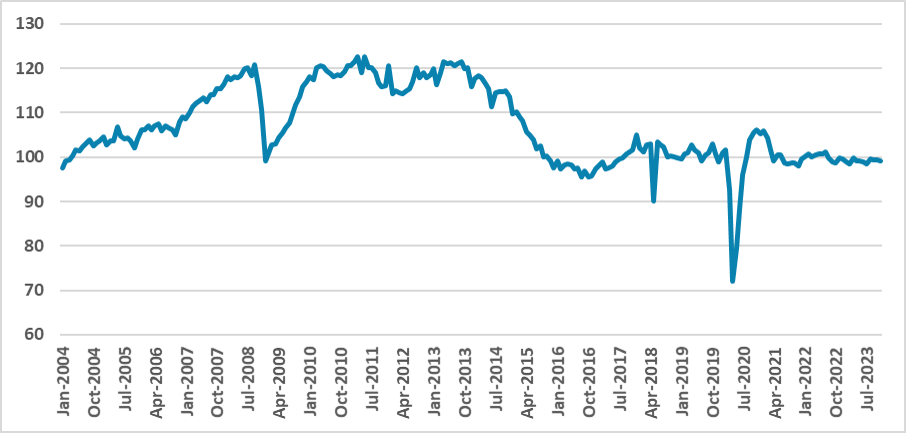Brazil: Government Launches New Industrial Plan, Same Old Policies and Limited Impact

The new Industrial Policy launched by the Brazilian Government aims to revitalize the struggling industry, focusing on six key sectors. Despite addressing issues like the "Brazilian Cost" and proposing substantial investments, skepticism lingers due to historical challenges and high production costs. Uncertainty surrounds the implementation of measures, and the industry may also contend with headwinds from China's slowed growth, raising doubts about the policy's short-term impact.
Figure 1: Brazil Industrial Production Index (2022 = 100, Seasonally Adjusted)
Source: IBGE
The Brazilian Government has launched its "new" Industrial Policy, entitled New Brazilian Industry. The policy focuses on six axes: (1) Agroindustrial Chain; (2) Health and Pharmaceutical Industry; (3) Infrastructure and Living; (4) Digital Transformation; (5) Green Economy; and (6) War Industry. The Policy has constituted several Working Groups to follow the actions of the plan. One group focuses specifically on reducing the so-called Brazilian Cost, excessive expenditures that enterprises need to make to operate in Brazil.
Since the 2015-16 crisis, the Brazilian industry has struggled, and it has mostly walked sideways, seeing limited growth. Unlike Mexico, which created an industrial hub fully integrated with the U.S. during the 1990s, Brazil's manufacturing industry is mostly focused on domestic consumption, apart from some motor vehicle chains integrated with Argentina. Mining and the Agroindustrial complex have seen more sustainable growth, as they are mostly focused on international markets.
The main instrument proposed by the policy relies on applying funds from both the National Development Bank (BNDES) and industrial agencies. The government plans to invest over USD 80 billion in actions to develop the industrial sector, both with non-refundable resources and loans. It is yet unclear whether the federal government will increase expenditures to capitalize the National Bank, as it was done in the past, or if BNDES will seek resources in the capital markets. It is also possible that BNDES will apply subsidized interest rates, implying a cost to be covered by the Brazilian Government.
The measures also state that specific new regulations will be issued to ensure that the public buys and uses specific national products, and some tariffs will be imposed on certain products to protect the national industry and reduce dependency on imports. Additionally, tax incentives and subsidies will also be given, although no further details were provided. Although the policy vaguely mentions the prospect of increasing industrial exports through national export agencies, there is some vagueness about how it will be implemented.
Overall, the new policy relives past policies that had a limited impact. Brazil's production costs are high compared to other countries due to the high level of taxes; therefore, apart from commodities production, Brazil's industrial products tend not to be very competitive on the international market. We are very skeptical that this new policy will produce any sort of impact in the short term. Additionally, industrial production will also face headwinds from China's lower growth.